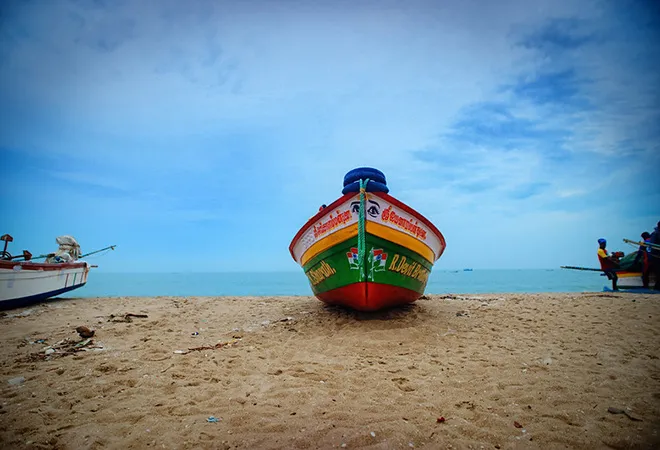-
CENTRES
Progammes & Centres
Location
The responses to the pandemic suggest a greater scope of regional cooperation among the countries in the Bay of Bengal region.
 This article is part of the series — BIMSTEC in 2021.
This article is part of the series — BIMSTEC in 2021.
First, BIMSTEC countries need to fast track the BIMSTEC Free Trade Agreement (FTA) negotiation. Two of the BIMSTEC member countries, namely, Myanmar and Thailand, are members of the RCEP (Regional Comprehensive Economic Partnership). An FTA within BIMSTEC will be a game changer in terms of promoting trade and value chains. It is a challenging task for the BIMSTEC member countries to conclude the negotiation when there are inconclusive views on RoO (Rules of Origin), Early Harvest Scheme, and Services Trade. Nonetheless, countries need to reach a consensus on FTA if they really want to benefit from the unfolding trade arrangement in the neighbourhood.
Second, non-tariff measures and procedures prohibit trade faster than inadequate infrastructure. The burden of NTMs (Non-Tariff Measures) in BIMSTEC is far higher than the remaining trade costs taken together. Since the COVID-19 outbreak, BIMSTEC countries have separately acted to expedite trade through contactless or paperless arrangements. For example, the BIMSTEC countries have inducted simplification of trade procedures and digital trade facilitation; all of them have introduced new/revised protocols. Countries have already reintroduced national protocols for trade and transport facilitation during COVID-19. However, these protocols do not cover the cross-border aspects of trade and transport facilitation. It is, therefore, recommended that the BIMSTEC may design a regional protocol for the trade and transport facilitation purpose applicable for the entire region in emergencies like the pandemic. This protocol may consider trade and transport-related actions, including facilitation of movement of goods and services; coordinated measures for enhanced controls of trucks and vehicles carrying goods; and surveillance systems for monitoring the health of transport crew; and enabling contact tracing, electronic tracking of goods and vehicles, digital freight corridors, amongst others.
Third, connectivity matters a lot to BIMSTEC. The achievement in coastal shipping between India and Bangladesh is phenomenal. The completion of the BIMSTEC Coastal Shipping Agreement will pave the way for seamless movement of cargo and passenger vessels in the Bay of Bengal. Abolition (partial or full) of cabotage among BIMSTEC countries will play the much desired catalytic role in promoting trade and connectivity. The Trilateral Highway (TH) is getting ready, thereby, leading to connect the BIMSTEC overland. Bangladesh has shown an interest towards joining the TH project. Bangladesh is on the verge of completing the Padma Bridge, which would better facilitate — when completed — trade and transportation. Bhutan and Nepal are already well connected with BIMSTEC, but require capacity augmentation. Border infrastructure and connectivity is another area that needs drastic reforms and development. Early completion of the BIMSTEC Motor Vehicle Agreement (MVA) will add huge momentum to BIMSTEC economic connectivity. Next, rail and digital connectivity have immense potential to enhance the trade in the region and beyond. BIMSTEC countries may negotiate a BIMSTEC Railway Agreement. Along with it, a regional air transportation agreement in cargo and passenger services will promote faster mobility of goods and services in sectors like tourism, health, and education. Maritime connectivity is another area which requires our utmost attention. Almost 25 ports are active in the Bay of Bengal, and BIMSTEC is yet to have a network of ports. A regional network of ports in the Bay of Bengal is essential to share vital information, undertake training and capacity building, and for working together to deal with common challenges, particularly in the post-COVID-19 period. A stronger network may be helpful to share best practices and will also assist in reaching better coordination.
Fourth, digitalising the trade processes in BIMSTEC would be the next step forward to make a giant leap toward a paperless trade environment. This would reduce the vulnerability of the global and regional supply chains. The BIMSTEC Secretariat may commission a study to identify the gaps in trade digitalisation processes in BIMSTEC in consultation with national governments. In this regard, the Framework Agreement on Facilitation of Cross-border Paperless Trade in Asia and the Pacific serves as a unique platform for member states of the Economic and Social Commission for Asia and the Pacific (ESCAP) to accelerate the post-COVID recovery. Bangladesh has already signed the ESCAP paperless trade agreement and the remaining BIMSTEC countries may consider acceding to this agreement.
Fifth, the region must collaborate on effective distribution of COVID-19 vaccines and movement of health professionals. This is an opportunity to enhances regional integration. There are other opportunities such as in trade finance, cross-border e-commerce, and innovative application of emerging technologies, amongst others. In particular, trade facilitation for e-commerce, where BIMSTEC countries have made little or no progress, should be taken up on urgent basis.
Finally, these are measures that may not only add to our strengths but also fulfil our commitments to the BIMSTEC integration process.
The views expressed above belong to the author(s). ORF research and analyses now available on Telegram! Click here to access our curated content — blogs, longforms and interviews.

Prabir De is Professor at the ASEAN-India Centre Research and Information System for Developing Countries (RIS) New Delhi.
Read More +